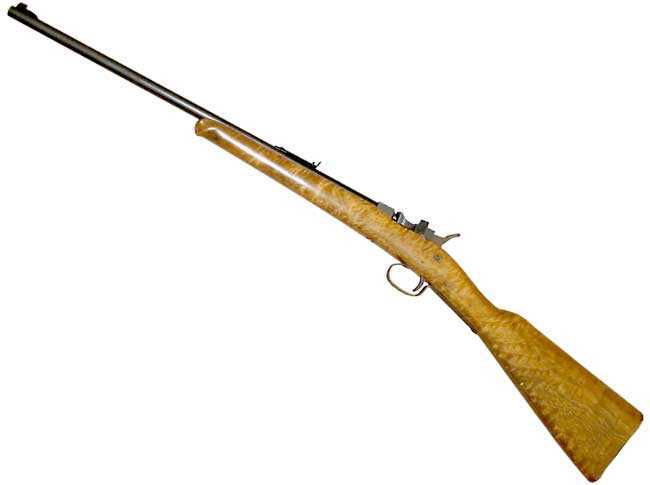
This is the actual rifle I’m testing. I won the lumber lottery with this one!
This report covers:
- “Many a slip…
- Increasing your firearms education
- Size matters!
- A difference
- Oily!
- The barrel
- Summary
Today we take a closer look at the .22 caliber breechloading black powder rifle once made by Rocky Mountain Arms Corporation (RMAC) of Utah.
“Many a slip…
… twixt the cup and the lip.” That’s another way of saying “Don’t count your chickens before they are hatched.” I had planned to start shooting the RMAC .22 rifle today, but I was careful to take my time while examining it this morning. I discovered that it is still full of oil from the factory. Oil and black powder don’t mix well.
I also wondered what I was going to shoot, since this rifle shoots a number 4 buckshot that is difficult to source anymore — at least in quantity. I was about to lament to you that my other unfired rifle came with a small bag of lead balls, when what to my wondering eyes should appear in this box but the same small bag of number 4 buckshot.
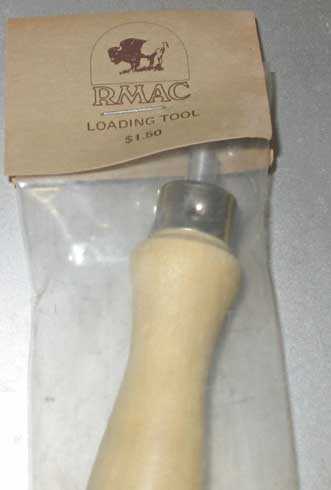
A collector wouldn’t do this, but I carefully removed the loading tool from the bag, so I can use it in this series.
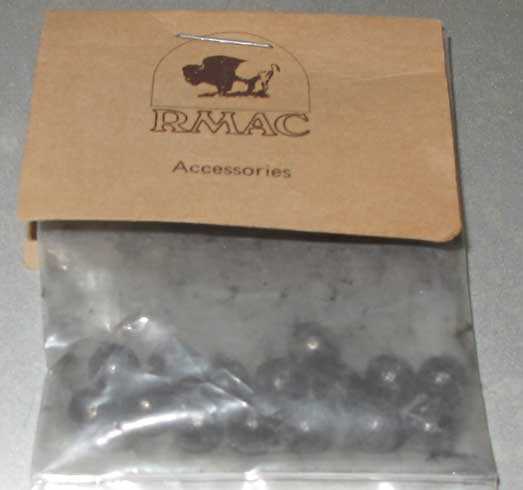
Once again, a collector wouldn’t open this package. But these are the only number 4 buckshot balls I have at present and there are things I need to know if I’m going to shoot this rifle.
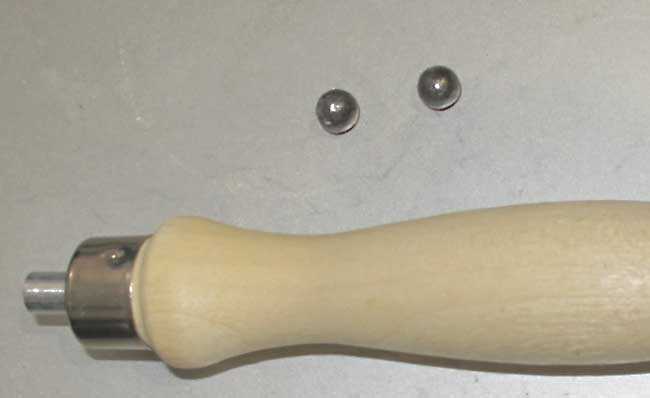
There are two lead balls and the loader. Think those “balls” are spherical? Think again!
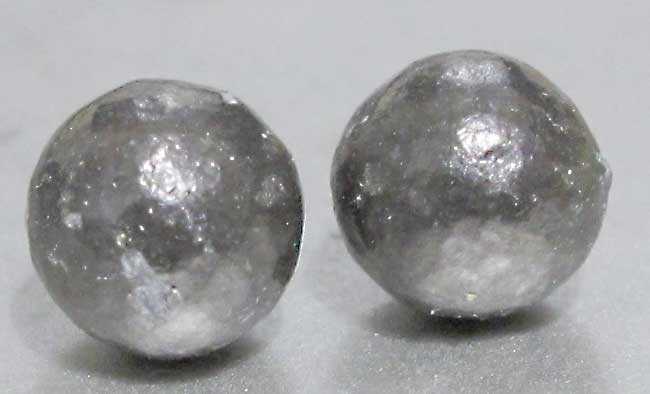
Those “balls” are only spherical from a distance. This is what buckshot looks like up close.
Now, number 4 lead buckshot is nominally 0.24-inches in diameter. Well, that is in a perfect world and you will seldom if ever see a buckshot that is spherical. Look at the one on the right. You can see that one won’t measure the same all around. So, what do these balls measure?
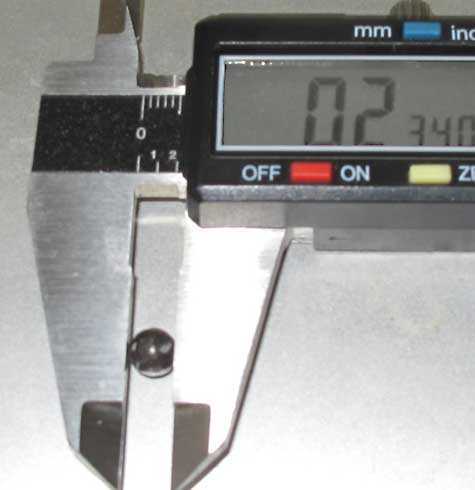
Well, measuring it that way I get 2.340-inches. Rotate the ball and get a different number.
The two balls I measured ranged from 0.231- to 0.239-inches in diameter. That’s pretty good, but not as close as swaged balls. The thing is — where do I find swaged balls, or even cast balls that size?
Increasing your firearms education
I’m going to seem to go off topic now, but really this is something you need to know, to follow this report. Cap and ball revolvers like the Colt 1860 Army are loaded by pouring black powder into each chamber of the cylinder, then ramming in a lead ball on top of that powder.
The guy in the video you are about to see also puts a grease wad (a cardboard wad he has soaked in olive oil) down on top of the powder. If you are going to shoot the gun right away, that’s no problem. If you wait a day after loading, you could have some misfires, due to the powder getting fouled by the oil.
I show the film to show you something else. After he rams the ball into the chamber, there is sometimes a thin ring of lead that has to be removed. It was sheared off the ball when it was rammed in. That is intentional. It prevents the fire from one chamber from jumping over to the neighboring chambers, resulting in a chain fire (several chambers firing at the same time) that is both dangerous and often ruins the gun.
Black power is very prone to explode in the presence of fire. So Colt and others tapered the entrance to each cylinder chamber so the ball was squeezed (swaged being the correct term) down, often shearing a thin ring of lead in the process. That kept the ball tight over the powder so no fire could get around and ignite the chambers that weren’t being shot. Now some people will put lard or vegetable shortening over all the chambers after they are loaded, but I have found that that stuff just melts and makes the gun an oily mess. However, I do like the olive-oil soaked cardboard wad idea and may try it if I ever load another cap and ball revolver. I might even try it with this rifle!
Size matters!
The balls that guy in the film loaded into his revolver were very round. They had been swaged round and were within one or two thousandths of an inch all over — as long as they were handled carefully. As you can see by the picture above, number 4 buckshot is not that round. This matters if I want to shoot this rifle a lot. I’m going to need more balls — BUT they have to fit this rifle! And now you understand what I mean by the word “fit.”
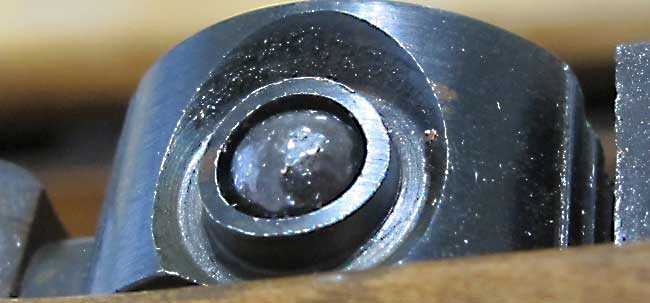
This is how a number 4 buckshot fits in the chamber of the RMAC rifle. It gets rammed into the chamber in the rotating breech by the loading tool.
The question is — where can I find pure lead balls that are close enough in size to work in this rifle? Well, I found them. A 25-pound bag of Remington number 4 buckshot cost me $117 plus change with tax and shipping. The price sure has risen in the past 10 years. I remember paying a quarter as much for a 25-pound bag of birdshot!
A difference
The 1860 Colt Army has a cylinder whose chambers swage down the balls when they are loaded. There might be a little of that going on with this rifle, but where it really swages the ball is when it shoots forward into the barrel. This is a single-shot, so there is no danger of a chain fire. And the ads said that the .24 caliber ball gets swaged down to .20 caliber when it enters the bore. We shall see.
Oily!
When I looked at the parts that will touch the powder and caps I discovered they were all oily. So the gun had to come apart and be cleaned. Easy-peasy!
Bring the hammer to half-cock, press down on the thumb latch and rotate the breech 90 degrees to the left. The cap cover that acts sort of like a hammer to pop the cap (remember — this rifle uses toy caps to ignite the black powder) slides right off the breech and there were at least 5 spare cap covers in the box. Hold down on the thumb latch and keep turning the breech to the left until the front of the breech faces the hammer (180 degrees) and the breech just lifts out of the receiver. Then cock the hammer fully and press the hammer extension (firing pin?) forward and it falls out of the receiver. Gotta go forward, though, because it’s too wide in front to go to the rear.
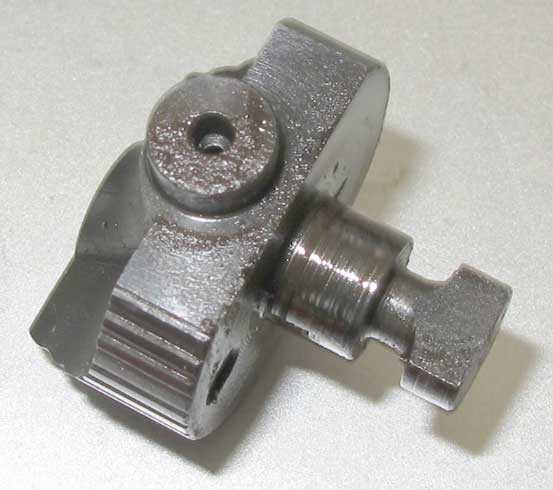
When the breech is rotated 180 degrees it lifts right out. The nipple (where the fire from the toy cap passes through to the powder) is facing you.
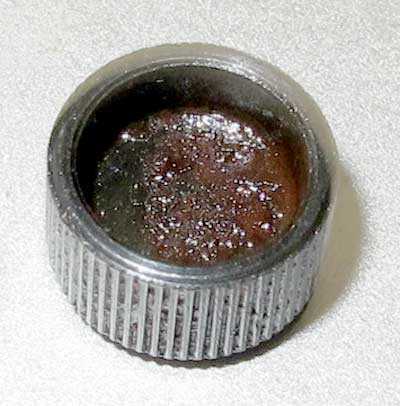
This is the cap cover that hits and explodes the caps when it’s struck by the “hammer extension” (firing pin?).
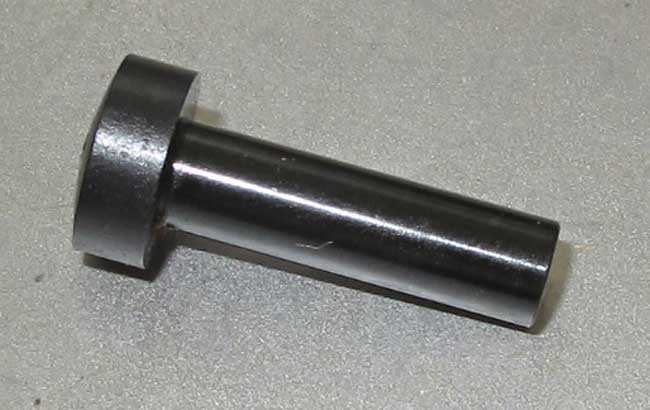
This hammer extension is struck by the hammer and it hits the back of the cap cover, which crushes the cap against the firing nipple, causing it to explode.
The barrel
Just for fun I peeked down the barrel and — OH, MY! It appeared filthy. It was probably just dirt attracted to the oil the factory put there but I cleaned it with solvent and cotton swabs anyway. I was concerned that since this rifle is supposed to really be a .20 caliber (that’s what their advertising literature said) that the cleaning rod wouldn’t fit, but it did. It was tight, but it did go all the way through.
Now, clean all the small parts with rubbing alcohol and dry them. After that the hammer extension is one place where a thin coat of lithium grease would work well. Then assemble the rifle.
Now that the gun is back together and now that I have a (more than) lifetime supply of ammo coming, I can shoot the rifle. Ironically, that’s what I set out to do at the start of this report, but all that other stuff got in the way. Well, I’ll shoot it next time. I’m not even going to explode a cap today because caps are corrosive and I would have to clean the entire gun after one shot.
Summary
You have now seen more deeply into the RMAC .22 breechloader than probably many people. Next time we will try to shoot it.

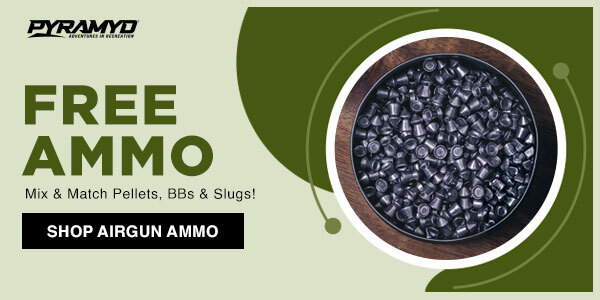
B.B.,
Given the results of reloading the .22 rimfire this might be a better alternative for small caliber fun. With multiple turrets, this could easily present sustained fire before needing to do a reloading session. Hopefully you will be able to shoot more than 10 rounds before needing to clean the bore. When you peeked down the bore was the rifling present all the way to the front or did it stop halfway or was there any at all? I can imagine how difficult it is to manufacture a squeezebore rifled barrel.
Siraniko
PS Section The barrel 2nd paragraph last sentence: “The (Then) assemble the rifle.”
Siraniko,
I haven’t given up on reloading .22 rimfire cartridges. I have just been working behind the scenes to figure out what to do.
I fixed that typo. Thanks,
BB
Very cool.
.24 down to a .20 is quite a difference. You will be shooting quite a pill shaped slug by the time it exits the barrel.
I wonder what the twist rate is?
On the revolver subject: Yes the grease over the balls melts and gets messy.
I used to make lubed felt wads when I shot black powder revolvers.
When I first got into the hobby the kit I built had a sample pack of percussion caps, some .451 diameter round lead balls and some lubed felt wads,
I was shooting it so much for fun and later in competition I would buy cheap wool hats from the thrift stores and used a empty .45 acp case with no primer to cut new wads, and then soak them in wonderlube 1000 or some other black powder lube then squeeze out the excess lube, and use them as wads either under the ball, or over the ball.
I never noticed any difference in accuracy either way, but if I was carrying it over a weekend outing or a days hunt, I put the wad over the ball just in case..
Can’t wait to see the results of shooting, I hope you can get it to go bang reliably.
Ian
Ian,
I wish I had known that little wad trick when I was shooting my Pedersoli 1851 Navy Colt. It might still be shootable. Back in ’74 there just was not much information around about shooting black powder. I had a lot of fun for quite a few years with that gun. I would not shoot it any more though. After a couple of double fires and a head space of almost a 1/4 inch, I crammed two lead balls down each cylinder and turned it into a wall hanger.
B.B.
You sure did win the lottery with that stock!
How long would it take an experienced person to reload all the chambers of the Colt 1860 revolver?
-Y
Yogi,
The guy in the video took his time. It used to take me about a minute to reload all 6 chambers.
BB
Yogi,
About thirty seconds. Maybe less if you are scared.
BB,
I do not know about the lumber lottery, but you sure did win the lottery with this one. With just a little work on that wood and a new trigger guard, that would be one sharp looking little rifle. In the picture that wood looks like it has some nice figuring in it.
You could also get in touch with somebody who builds muzzle loaders and maybe work out a deal for a full length stock for this. Of course then I would have to have a new rotating breech made that would accept percussion caps.
Oh yeah, this would be a fun little popper to own. You won the lottery alright.
BB,
Well, I cannot say I am a fan of this new blog format, app, software, whatever. Right now the headings are black, but the text is gray and there are no pictures above the red picture captions.
Oh, and I still do not receive email notifications.
P.S. I also cannot edit previous comments.
RidgeRunner, what do you use to access the blog, specifically? What device, operating system, etc.? You are such a frequent contributor it is a shame that you are having such trouble. Perhaps I or others can assist in some way?
I am using an Acer laptop and that wonderful Windows 10 platform that was to be the the end, but now they will be introducing W 11 soon. My email is through TDS.
Ridgerunner, on the emails, run through the basics, like making sure your WordPress profile has the right email address (look for an extra space at the end that sneaks in or a zero that should be a letter O, etc). Then I noticed that emails generated from the blog, at least in my Gmail account came in as from “Pyramyd,” but when you looked at the true sender it was “Pyramyd AIR • tom@pyramydair.com,” so perhaps you need to save that sender as a “safe sender” somehow. Do you use Internet Explorer or Edge to surf the web and view the blog? Try Firefox or another browser. Internet explorer also has “Compatibility View” settings that you might try to see if they make any difference. Otherwise, you might try viewing the blog from another device or even create a new profile to see if it works any differently than your current profile. Good luck.
BB, I wish I had some #4 shot to share with you. At one point I was going to buy some # shot for some reason but I never bought it. If the gun is going to swage down to 20 caliber could you use a 25 caliber pellet?
David Enoch
David,
Thanks for the wel-wishes. I have 25 pounds of shot coming, and I think I will stick with it.
BB
BB
Like Ian said above I prefer placing the gooey wad or just Crisco above the ball. No telling what that soup would do after a year or so sitting in the bedside drawer for protection.
Deck
Deck,
You know I never thought about putting Crisco on the ball. Since this is a single shot, that would be the easiest.
BB
B.B.,
Why would you need to apply Crisco on top of the ball in this single shot rifle?
Siraniko
Siraniko
Probably to help it swage.
Siraniko,
The Crisco will keep the powder fouling soft and each ball shot will remove it. This is what we do with black powder arms, unless we swab the bore with water between shots.
BB
BB
FM’s poor mom never could understand why he needed Crisco for his muzzleloader; she just thought it was another of her son’s crazy notions. Maybe should have invited her to a musketry session and gotten her into percussive cookin’.
B.B.,
This is one cool little rifle, and I’m looking forward to your reports on how it shoots. But it also got me to thinking; I’ve been researching how much of a black powder charge it would take to make my .50 caliber Hawken subsonic, just for some light plinking fun. And that got me to thinking, has anyone ever made a scaled down Hawken that would propel a .177 or .22 perfect round with either a #11 cap, or a very light powder charge? I’ve read that, in the past, on the frontier, they didn’t like to go below .32 caliber as they didn’t want to break the wooden ramrod. I also read an article that claimed that small lead balls would “melt” from too much powder charge. I looked online, and I haven’t seen any muzzleloader barrels for sale below .32 caliber. But this little rifle on which you are reporting made me think of how cool it would be if I could have a Hawken like my .50, but in .22 caliber; that way I could load it up with just a few grains and shoot at airgun velocities (like 900 fps); then I could shoot practice matches for the muzzleloader shoots at home…but without ticking off the neighbors (or the golf course) to the point where they’d want to come and lynch me. =>
Take care & God bless,
dave
Dave,
To the best of my knowledge, no. A .22 muzzle loader like that doesn’t exist. But I own a .32 Thompson Center rifle that is almost like that. I think the max load is 20 grains of powder and I bet 10 grains would work fine. They are a lot of fun to shoot and very inexpensive, as well.
BB
Cool,, B.B.! Thanks for that info. =>
Dave,
There are quite a few DIY bp MZ .25+ Caliber Long Rifles being built by individuals.
shootski
Dave and BB
I suppose that you are aware of the indoor shooting system of Pedersoli. It’s a very good training/fun project for the basement.
Bill
Bill, no I was not aware of that, but I will research it now that you told me; thank you! =>
Thedavemyster,
You have got to get to the gunsmith shop at Colonial Williamsburg Dave.
Lot’s of speculation on the Internet Forums very little historical knowledge. The real reasons for old MZ bore size limitations:
https://ethw.org/Barrel_Boring
This is funny! Spinning Wheel????
http://rogersallsphotos.com/prints/colonial-williamsburg-spinning-wheel
I don’t think so!
Enjoy,
shootski
Wow, Shootski, that’s some cool links and a great history lesson; thank you!
BB,
Please take note that toy caps are typically chlorate based, and thus corrosive. Clean the gun well.
Mel,
Absolutely!
BB
BB,
Wish I knew you needed #4 shot, I have as stash bought from a gunshot bargain bin a few years ago.
I have been an avid muzzloader and revolver shooter. I would recommend T/C bore butter over crisco. I use the butter on my Centerfire revolvers to dramatically reduce leading. Just a fine coat in the bore and chamber mouths works wonders. I think it’s lanolin based. Also Fluid Film works well.
I have always used felt wads under the revolver ball. I never ever had a chain fire, and I used to shoot 3-4cylinders daily.
The small bore black powder rifles foul quicker and easily, I have found.
I ran out of primers weeks ago, so I’m at the range with my air rifles every week. The Winchester 435 made some cloverleaf clusters yesterday @ 25 yds.
Rob,
When will I learn what wonderful resources we have right here? Well, it looks like I already sold half of what I bought, so it isn’t as bad as it sounds.
I have TC Bore Butter so I will try it.
Thank you,
BB